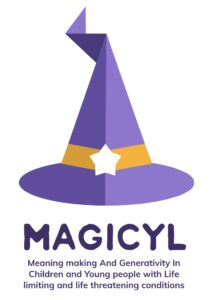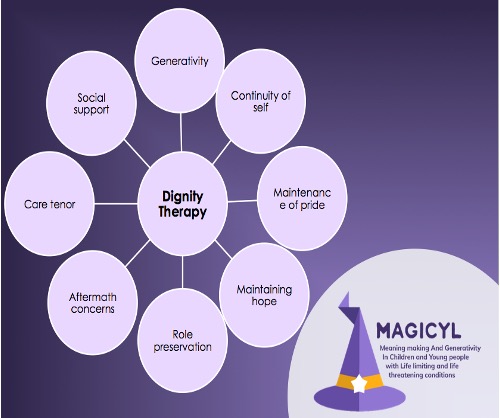This week’s blog will briefly summarise the aims, scope and development of a Dignity Therapy-based app protype ‘DIGNISPACE’ for young people with life-limiting conditions.



We are core members of the MAGICYL (Meaning making And Generativity In Children & Young people with Life limiting conditions) research team, with a shared passion that dignity, and related psychological/emotional and spiritual needs are understood, valued and central to care. Meeting the psychological/emotional and spiritual needs of young people at the end-of-life can be challenging for health and social care professionals and families. DIGNISPACE is a supported intervention whereby health and social care professionals can assist young people and families to engage in life review, meaning making and legacy leaving.
What is Dignity Therapy?
Dignity Therapy (DT) is a brief psycho-therapeutic intervention that assists individuals with shortened life expectancies to have meaning and purpose (Chochinov, 2012). DT was developed following the construction of the Dignity Conserving Model of Care (Chochinov, 2002). During DT, trained professionals encourage patients to think about and discuss their most valued memories and share their future hopes, which culminates in a legacy document that can be shared with others of the patient’s choosing, prior to or post their death.
Is Dignity Therapy relevant for young people with life limiting conditions?
While DT is becoming established in adult settings, further research on its usefulness across different contexts for younger populations is required. There is often lack of opportunity for young people to engage in meaningful discussion about dignity and legacy leaving and end of life care in a structured way (Rodriguez et al., 2018). Our extensive patient, carer and public involvement activities found that a DT type intervention/s would be acceptable (Watts et al., 2018). Young people said:
‘I think anyone who is facing death, they would want to know that someone is going to remember them, and something made their life worth while’ Young Person 2
‘I think it would be good to adapt it (DT) slightly for young people to make it more suitable to the current day, for example incorporating modern technology. I think using a “vlogging” type system may be good to record special memories or thoughts which could then make a larger video. Another way would be to use social media more’ Young person 1 (Watts et al., 2018).
What did we find? How did we develop DIGNISPACE?
We undertook a qualitative study, with data collection including interviews (young people) and focus groups (professionals). Data were analysed using the framework approach, which informed the digital development and content of a digital intervention – DIGNISPACE. The DIGNISPACE app prototype was then evaluated using a mix of interviews and focus groups with young people, family carers and professionals. Our work was guided by an advisory group that included young people with life limiting conditions and family carers.
More work is planned to develop training packages and to further develop and feasibility test DIGNISPACE in practice.
DIGNISPACE has potential to meet the psychological/emotional and spiritual needs of young people with life-limiting conditions. The supported digital intervention has the functionality to include families where appropriate, be flexible with multi-media content, facilitate the use of varied communication media and languages and encourage legacy content for multiple others. DIGNISPACE could be accessed across illness trajectories or for several weeks/months as a dedicated project to record and reflect on life experiences.
What are the potential implication implications for practice?
- DIGNISPACE could support existing advanced care planning protocols and help professionals to work with young people who want to engage in challenging conversations.
- DIGNISPACE could be led by the young person, with professional / family support, and has broader application in supporting young people to make sense of their life / condition and record aspects of their life that are important to them.
- DIGNISPACE has particular relevance for young people who are isolated and find it difficult to share their feelings, with facilities to alert professionals / support person or share content as appropriate.
You may wish to read our full study findings:
Rodriguez, A. M., Kellehear, A., Lanfranchi, V., McSherry, W., Tatterton, M., Watts MBE, L., Yaziji, N., & Smith, J. (2023). The Qualitative DIGNISPACE Study: The Co-Design of a Life Review, Meaning-Making and Legacy Leaving Digital Intervention for Young People with Life-Limiting Conditions. Illness, Crisis & Loss, online. https://doi.org/10.1177/10541373231202842
Dr Alison Rodriguez is an Associate Professor Child & Family Health, School of Healthcare, University of Leeds. You can follow Alison on X:@ARodriguez339
Professor Joanna Smith is a Professor of Nursing in Child Health at Sheffield Children’s NHS Foundation Trust and Sheffield Hallam University. You can follow Jo on X: @josmith175
Dr Michael Tatterton is a Clinical Associate Professor, University of Bradford and the Clinical Director, Bluebell Wood Children’s Hospice. You can follow Michael on X: @MJTatterton
Useful additional reading:
Chochinov, H.M. (2012) Dignity Therapy: Final words for final days. Oxford: Oxford University Press.
Chochinov, H. M. (2002) Dignity conserving care: a new model for palliative care. JAMA, 287, 2253-2260.
Watts, L., Rodriguez. A., Tatterton, M., Mc Sherry, W., Smith, J. (2020) Stakeholder perceptions of Dignity Therapy for children and young people with life-limiting conditions study. Integrative Therapies in Palliative Care, 5(1), doi:10.21926/obm.icm.2001012
Rodriguez, A., Smith, J. & McDermid, K. (2018) Dignity therapy interventions for young people in palliative care: a rapid structured evidence review, International Journal of Palliative Nursing, 24, (7), 112-121.

